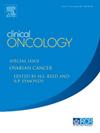A Nomogram to Estimate Locoregional Recurrence-Free Survival for Women With T1-2 N0 Breast Cancer Managed With or Without Postmastectomy Radiotherapy
IF 3
3区 医学
Q2 ONCOLOGY
引用次数: 0
Abstract
Aims
Postmastectomy radiotherapy (PMRT) in women with T1-2 N0 breast cancer is not routinely recommended by guidelines but is sometimes considered when patients have multiple predictors of locoregional relapse (LRR). This study re-evaluates the role of PMRT in the era of modern systemic therapy.
Materials and methods
Patients with pT1-2 pN0 M0 breast cancer treated from 2005 to 2014 with total mastectomy were identified. Patients who had prior or synchronous breast cancer, neoadjuvant chemotherapy, or incomplete radiotherapy courses were excluded. LRR was analysed with a Fine-Gray subdistribution hazard model, and overall survival (OS) was analysed with Cox regression. A nomogram for estimating LRR was devised and validated with propensity score matching.
Results
The study cohort included 3752 women with negative margins and a median follow-up of 11.4 years. As systemic therapy, 32.4% had chemotherapy, 70.2% had hormone therapy, and 10.7% had targeted therapy. The 10-year LRR for the study cohort was 3.7%. The 358 PMRT patients had more adverse features than the 3394 no-PMRT patients. LRR was increased by seven predictors: younger age, larger primaries, luminal B or triple-negative subtypes, lymphovascular invasion (LVI), close margins, omission of chemotherapy, and omission of hormone therapy. PMRT receipt was associated with decreased LRR (HR=0.53, P = 0.04) but did not affect OS. Our nomogram only predicted absolute LRR risks >10% without PMRT when combinations of four or more predictors were present. Only 5% of patients had four or more predictors. The nomogram’s predictions for PMRT benefit were within 1% of the predictions based on the higher-risk, propensity-score-matched cohort.
Conclusion
For T1-2N0 breast cancers treated in the era of modern systemic therapy, PMRT did not influence OS. However, there is a small subgroup of high-risk patients for whom PMRT offers a meaningful LRR reduction. Our nomogram can help individualise PMRT decision-making for patients with multiple LRR predictors.
评估T1-2 N0乳腺癌患者接受或不接受乳房切除术后放疗的局部无复发生存率的Nomogram (Nomogram)
目的对T1-2 N0型乳腺癌患者进行乳房切除术放疗(PMRT)并不被指南常规推荐,但当患者有多个局部复发(LRR)预测因素时,有时会考虑采用PMRT。本研究重新评估PMRT在现代全身治疗时代的作用。材料与方法选取2005 - 2014年接受全乳切除术的pT1-2 pN0 M0乳腺癌患者。排除既往或同步乳腺癌、新辅助化疗或放疗疗程不全的患者。LRR采用Fine-Gray亚分布风险模型分析,总生存期(OS)采用Cox回归分析。设计了一个估计LRR的nomogram,并通过倾向评分匹配进行了验证。结果该研究队列包括3752名阴性切缘的女性,中位随访11.4年。作为全身治疗,化疗占32.4%,激素治疗占70.2%,靶向治疗占10.7%。该研究队列的10年LRR为3.7%。358例PMRT患者比3394例未进行PMRT的患者有更多的不良特征。LRR因以下七个预测因素而增加:年龄更小、原发较大、管腔B或三阴性亚型、淋巴血管浸润(LVI)、切缘闭合、遗漏化疗和遗漏激素治疗。接受PMRT治疗与LRR降低相关(HR=0.53, P = 0.04),但对OS无影响。当存在四个或更多预测因子的组合时,我们的nomogram仅能预测无PMRT的绝对LRR风险>;10%。只有5%的患者有四个或更多的预测因子。nomogram对PMRT获益的预测与基于高风险、倾向评分匹配队列的预测在1%以内。结论在现代全身治疗时代治疗的T1-2N0乳腺癌,PMRT对OS无影响。然而,有一小部分高风险患者,PMRT提供了有意义的LRR降低。我们的nomogram可以帮助具有多个LRR预测因子的患者个性化PMRT决策。
本文章由计算机程序翻译,如有差异,请以英文原文为准。
求助全文
约1分钟内获得全文
求助全文
来源期刊

Clinical oncology
医学-肿瘤学
CiteScore
5.20
自引率
8.80%
发文量
332
审稿时长
40 days
期刊介绍:
Clinical Oncology is an International cancer journal covering all aspects of the clinical management of cancer patients, reflecting a multidisciplinary approach to therapy. Papers, editorials and reviews are published on all types of malignant disease embracing, pathology, diagnosis and treatment, including radiotherapy, chemotherapy, surgery, combined modality treatment and palliative care. Research and review papers covering epidemiology, radiobiology, radiation physics, tumour biology, and immunology are also published, together with letters to the editor, case reports and book reviews.
 求助内容:
求助内容: 应助结果提醒方式:
应助结果提醒方式:


